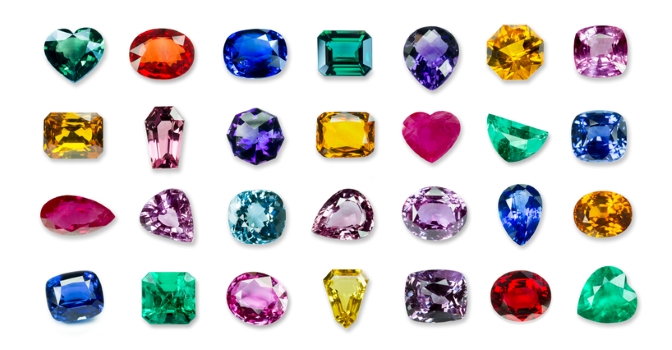Are you learning how to use gemstones? Including gemstones in jewellery can really add that special touch to your latest design but, when you are just getting started, choosing which gemstones to use can be a little scary. With so many options to choose from – including different shapes, cuts, sizes, weights and finishes – knowing your diamonds from your cubic zirconias can be overwhelming.
That is why I have created this short guide on gemstones for beginners, to help you get started in the wonderful world of gemstones.
Gemstone Guide
Gemstone durability
When looking for information about gemstones in jewellery, you will commonly see their “hardness” mentioned – such as 10 for diamond or eight for topaz – but this is only one of three factors that make up gemstone durability. Choosing the right strength of gemstones for beginners is a key factor in creating jewellery. A breakdown of the three elements of gemstone durability are:
- Hardness – This is how hard the surface of the gemstone is and the reference point for hardness is the Mohs scale – which runs from one (talc) through to 10 (diamond). The harder the stone, the better its ability to resist scratching and abrasion.
- Toughness – This is the internal strength of the stone – how well it can resist fracturing (non-directional breakage) and cleavage (directional breakage). Unlike hardness, there is no recognised scale for this, but it generally ranges from poor (tanzanite, emerald) to excellent (Jade).
- Stability – This is the ability to resist both physical (heat and light) and chemical (exposure to acids) changes. As with toughness, there is no recognised scale for this, but it ranges from poor (opal, pearl) to excellent (diamond).
Learning more about gemstone durability will make it much easier to work with gemstones for beginners. But what are the uses of gemstones? Find out more in our gemstone guide below.
Using gemstones for beginners: top tips
#1 Soldering and pickling
Stone setting is usually done once all of the metalwork is finished, this is because it prevents the stone from being accidentally damaged. But there are times when a piece needs to be soldered and pickled when the stone is in place, such as repairs.
And this is where stability comes into play, as being exposed to the heat of a jewellers’ torch and/or being placed in a pickling solution can seriously damage the stone – which is often irreversible. In most cases, the best option is to remove the stone before doing any soldering.
Care should be taken when soldering stones still in the setting as, without some form of heat protection, the surface of the stone can oxidise (even with very stable gemstones, such as diamonds).
#2 Stone setting
For lots of jewellers, stone setting is one of the scariest things to do as they are worried about breaking the stone. And as someone who does setting myself, I completely understand but knowing a little about the stone you are setting can make the process a bit less stressful.
This is because when you know what the hardness and toughness of the stone is, you can adapt your setting style.
For example, with soft and more brittle stones (such as peridot or opal), you have to be more careful and not apply too much pressure on the stone – instead a slow and steady approach with lots of small adjustments, ideally using brass rather than steel tools, is generally the best way to go.
With harder and tougher stones, such as diamond or sapphire, you can apply more pressure on the stone – although care does still have to be taken. They can also be a little more forgiving if you slip, as the stones are generally harder than the metal the tool is made of.
#3 Finishing and polishing
The final part of the jewellery making process is finishing and polishing. It is still possible to damage the stone at this point, so care needs to be taken, especially when cleaning up the setting.
This is because abrasives, such as sandpaper and rubber wheels, can damage softer stones – harder stones, such as diamonds, rubies and sapphires, are usually ok.
But on softer stones, these abrasives can take the surface off the stones and may leave a dull finish – and if you’re not careful, the complete removal of a facet from a stone (I learnt that one the hard way!). Ideally, you want to use an abrasive that is softer than the stone.
A similar issue can be found if you are using a very aggressive polishing compound, as it can affect the surface of the gemstone. Once the gem is set, you don’t really want to use anything more aggressive than pre-polish (Tripoli, Luxi Blue etc.) and then your finishing polish.
#4 Cleaning
Once you have finished polishing, it is time to get the piece clean and sparkly – but once again, care needs to be taken when doing this as ultrasonics and steam cleaners aren’t suitable for all types of gemstones in jewellery.
For example, with brittle stones, such as emeralds and tanzanite, the ultrasonic waves can in some cases cause the stone to break. Another side effect with emeralds is that they are often fracture filled with oils that can be removed by the ultrasonic cleaner.
It is a similar story for steam cleaners, and that is why both should only be used with a higher gemstone durability, such as that within diamonds and sapphires.
The best option in most cases is the classic mixture of warm water, a small amount of washing up liquid, a soft bristled brush and a bit of elbow grease.
What are the uses of gemstones in jewellery?
Gemstones can be used within a range of crafting and jewellery making projects, from intricate necklaces and drop earrings to tennis bracelets and bespoke brooches. Find out how to choose the right stone for your design below.
Gemstones for beginners: what’s the right stone for the job?
Knowing how to work with different kind of gemstones for beginners can also translate to choosing the right stone for a piece of jewellery you are doing for yourself, or as a commission for a customer.
Are you using gemstones for a ring, earrings or pendant?
If you have to take more care of the stone when it is with you at the bench, there is a good chance that the gemstone isn’t really suitable for use in a ring.
Emeralds, tanzanite and opals are also great examples of this, as they have to be treated with a lot of care as their gemstone durability is quite low – and this generally means that being worn in a ring, especially one that is worn everyday, isn’t going to do the stone much good.
Instead, they are better suited to being used in a pendant or pair of earrings, as their life will be much easier, with less chance of the stone getting broken or damaged.
For everyday rings such as engagement rings, a stone that is durable is going to be a much better option and is one of the reasons why diamonds are such a great choice.
If you have a customer who wants to use a soft stone in an everyday ring, talking through and explaining the reasons why it is not the best option can save a lot of time, hassle and, in some cases, heartache (on both sides).
Gemstone guide: choosing your setting
Knowing how durable a gemstone is can have a big influence on the type of setting that you are going to use, as different styles of settings will offer different levels of protection.
This is also useful if the customer is adamant on having a gemstone in a ring that is not particularly durable.
For softer and more brittle gemstones in jewellery, a rub over or bezel setting is often the best option. This is because, not only does the setting provide more protection for the stone but, the setting process can be more gentle.
If the gemstone is more durable, then more exposed settings such as claw or prong settings can be a great option as they don’t require as much protection against day-to-day knocks and bangs.
Gemstones for beginners: where to learn more
To learn more about the points discussed in this gemstone guide, there are some great books out there that you can use as reference guides at the bench.
One of these is: “Working With Gemstones, A Bench Jeweller’s Guide By Arthur Anton Skuratowicz And Julie Nash”, available at Cooksongold. I looked through this book when completing the demonstration days last year, and it contains lots of practical information about lots of different gemstones for beginners.
And that’s Paul Haywood’s guide to using gemstones for beginners. Now you know how to use gemstones, and how to choose which gemstones to use in jewellery, pick up all of your supplies from Cooksongold – where you can find everything mentioned within this gemstone jewellery guide, and much more.

Paul Haywood

